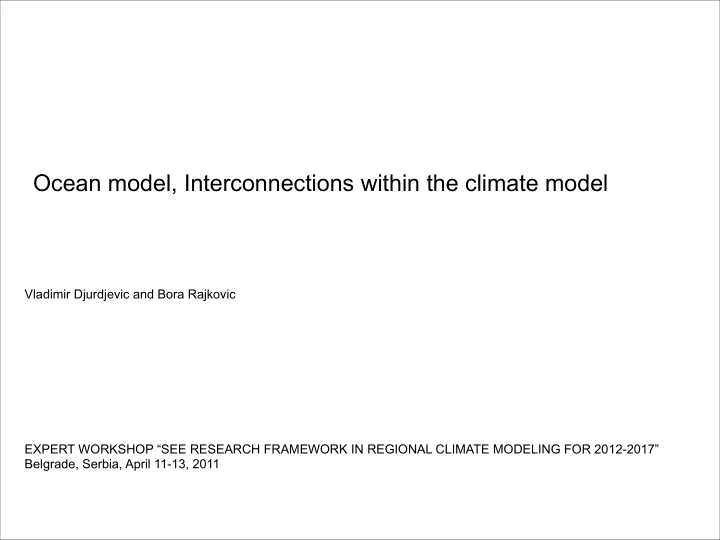

Ocean model, Interconnections within the climate model Vladimir Djurdjevic and Bora Rajkovic EXPERT WORKSHOP “SEE RESEARCH FRAMEWORK IN REGIONAL CLIMATE MODELING FOR 2012-2017” Belgrade, Serbia, April 11-13, 2011
Interaction between atmosphere and ocean plays important role for many processes in both medium. Interaction happens on all possible spatial and time scales. spatial scales: meters - ocean surface ocean waves planetary - ENSO, thermohaline circulation time scales: daily - hurricanes, sea-land breeze decade to century - global ocean circulation, The Atlantic Meridional Overturning Circulation (source: Large 2008) From Kuhlbrodt et al. (2007) (source: Jungclaus)
Exchanges between atmosphere and ocean: momentum exchange formation of ocean currents heat exchange, turbulent and radiation fluxes mixed layer mass exchange fresh water flux gases and chemical exchange CO2 uptake, deposition of minerals in atmospheric aerosols (source: http://www.oceanclimate.se/research_atmosphere_ocean_interaction.htm)
Approaches for ocean modeling and coupling Q-flux, mixed layer model or slab ocean models • model without ocean dynamics • each grid cell in the ocean is given a temperature and a depth for the mixed layer • energy convergence (divergence) at each grid cell is calculated based on the heat storage capacity of the surface ocean and the vertical energy fluxes at the air/sea interface • allows the ocean to adjust to the surface air temperature advantages: simple for implementation suitable for different climate experiments CPU efficient disadvantages: no ocean dynamics training run - fluxes are derived from specified SST control runs where the specified SSTs are from climatology (source: http://forums.edgcm.columbia.edu/showthread.php?p=315)
Approaches for ocean modeling and coupling K Profile Parameterization (KPP) mixed-layer ocean model Example from seasonal forecast in ECMWF (Vitart, 2008): • mixed layer model is based on the KPP scheme (Large et al., 1994). • vertical domain of 200 m with 29 vertical levels • vertical grid is stretched so that the top model level is 1.4 meter thick with 16 levels in the top 20 meters. • model includes penetrative short wave radiation using the double exponential of (Paulson and Simpson 1977) for Jerlov water type IB (Jerlov, 1976) • the mixed layer domain extends to +/- 44o of latitude (source: Vitart, 2008) Linear correlation between the inter annual variability of precipitation from Indian station data averaged over pentads in June from 1991 to 2007 and the ensemble mean precipitation predicted by OGCM (blue) and ML (red)
Approaches for ocean modeling and coupling OGCMs - Ocean General Circulation Model solve the primitive equations for global incompressible fluid flow analogous to the ideal-gas primitive equations solved by atmospheric GCMs ocean dynamics is important on centuries scales, and all ‘modern’ AOGCM have OGCM an explicit representation of the sea surface height is being used in many models, and real freshwater flux is used to force those models instead of a ‘virtual’ salt flux between IPCC TAR and AR4 : most AOGCMs no longer use flux adjustments , which were previously required to maintain a stable climate rotated and three pole horizontal grids are adopted to avoid problem North Pole coordinate singularity increased horizontal resolution in tropics
Approaches for ocean modeling and coupling Examples of OGCM: NEMO: 4 major components • the blue ocean (ocean dynamics, NEMO-OPA) • the white ocean (sea-ice, NEMO-LIM) • the green ocean (biogeochemistry, NEMO-TOP) • the adaptive mesh refinement software (AGRIF) incorporated in Met-Office models HadGEM3 family (climate research) and GloSea4 (seasonal forecast)
Approaches for ocean modeling and coupling Examples of OGCM: HOPE (Hamburg Ocean Primitive Equation model): full primitive equation, free surface model, E-grid formulation, sea ice model The ocean model has a variable resolution going from about 0.3 degrees of latitude at the equator to about 1.4 degrees in the extratropics by about 1.4 degrees in longitude everywhere incorporated in System 3 (ECMWF seasonal forecast)
Approaches for ocean modeling and coupling Examples of OGCM: MITgcm (MIT General Circulation Model): • has a non-hydrostatic capability • supports horizontal orthogonal curvilinear coordinates incorporated in PROTHEUS (ENEA), for regional climate studies in Euro-Mediterranean region.
Approaches for ocean modeling and coupling Examples of coupled regional climate model stretched ARPEGE-Climate or the LAM ALADIN-Climate with OPAMED8 and now NEMOMED8 PROTHEUS system, RegCM3 with MITgcm EBU-POM, Eta/NCEP with POM (Princeton ocean model) MED-CORDEX
Approaches for ocean modeling and coupling Belgrade experience: EBU-POM/CRM-SEEVCCC Different aplications: -medium range forecast climate change -climate change experiments scenarios -seasonal forecast forecast climate integrations reanalyses downscaling
Approaches for ocean modeling and coupling Belgrade experience: Seasonal forecast with regional coupled model
Approaches for ocean modeling and coupling Coupling strategies (Valcke and Guilyardi, 2008 ) Merging of the codes • information can be exchanged by argument passing or by sharing a common module • ensures efficient memory exchanges • must be hard-coded • own transformations and interpolations • EBU-POM approach Direct use of existing communication protocols • MPI • CORBA • Unix pipes • scientist masters the communication protocol and implements his own transformations • and interpolations
Approaches for ocean modeling and coupling Use of a coupling framework • ESMF (http://www.esmf.ucar.edu) • adapt the code units to the framework standard data structure and calling interface • approach is fully flexible (the different units can be easily reused in different • allows the user to use the different tools offered by the framework (parallelisation, regridding, time management, etc.) • requires a deeper level of interference in the codes and imposes strict coding rules in order to take full advantage of the framework functionalities • NMM-B is incorporated already in ESMF Use of a coupler • MCT (http://www.mcs.anl.gov/mct) • PALM (http://www.cerfacs.fr/globc/PALM WEB/index.html) • OASIS (https://oasistrac.cerfacs.fr/) • ensures that the original codes will run as separate executables with main characteristics (e.g. internal parallelisation) unchanged with respect to the uncoupled mode • some cases be less efficient than a more integrated one-executable approach
Recommend
More recommend